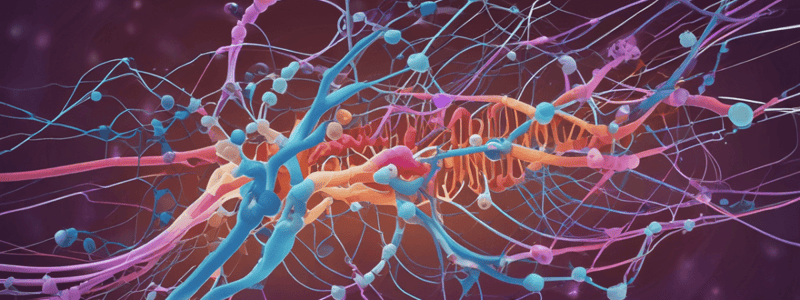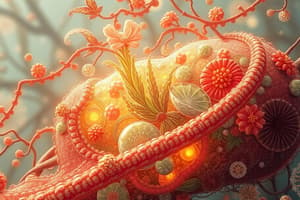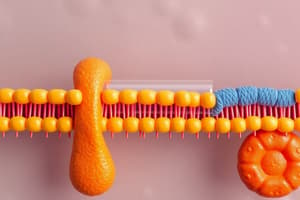Podcast
Questions and Answers
What is the main responsibility of the helices mentioned in the text?
What is the main responsibility of the helices mentioned in the text?
- Producing energy for the cell
- Transporting oxygen
- Recognizing and binding specific signal molecules (correct)
- Regulating cell growth
Which of the following is NOT a role of the transmembrane domain mentioned in the text?
Which of the following is NOT a role of the transmembrane domain mentioned in the text?
- Recognizing specific signal molecules
- Generating electrical signals in cells (correct)
- Facilitating cell communication
- Binding neurotransmitters and hormones
What type of molecules do the helices primarily interact with?
What type of molecules do the helices primarily interact with?
- Lipids
- Water molecules
- Carbohydrates
- Signal molecules like neurotransmitters and hormones (correct)
In a cell, what do the helices embedded in the membrane specifically recognize?
In a cell, what do the helices embedded in the membrane specifically recognize?
Which function is NOT associated with the transmembrane helices mentioned in the text?
Which function is NOT associated with the transmembrane helices mentioned in the text?
What is the primary reason for different types of GPCRs having distinct binding capacities?
What is the primary reason for different types of GPCRs having distinct binding capacities?
Which factor plays a key role in determining the binding capacities of GPCRs?
Which factor plays a key role in determining the binding capacities of GPCRs?
What aspect contributes to the diversity in binding capacities among various GPCR types?
What aspect contributes to the diversity in binding capacities among various GPCR types?
Why do GPCRs with similar structures still exhibit different binding capacities?
Why do GPCRs with similar structures still exhibit different binding capacities?
Which feature primarily contributes to the specificity of ligand binding by different types of GPCRs?
Which feature primarily contributes to the specificity of ligand binding by different types of GPCRs?
What is the role of adenylyl cyclase in the cAMP signaling pathway?
What is the role of adenylyl cyclase in the cAMP signaling pathway?
How many cAMP molecules bind to each regulatory subunit of protein kinase A (PKA)?
How many cAMP molecules bind to each regulatory subunit of protein kinase A (PKA)?
What happens to the catalytic subunits of PKA when cAMP binds to the regulatory subunits?
What happens to the catalytic subunits of PKA when cAMP binds to the regulatory subunits?
What is the role of active PKA catalytic subunits in the signaling pathway?
What is the role of active PKA catalytic subunits in the signaling pathway?
How does phosphorylation of target proteins by active PKA catalytic subunits affect cellular processes?
How does phosphorylation of target proteins by active PKA catalytic subunits affect cellular processes?
Why is the PKA signaling pathway tightly regulated?
Why is the PKA signaling pathway tightly regulated?
What does the final step produce?
What does the final step produce?
Which compound is considered a crucial intermediate in various metabolic pathways?
Which compound is considered a crucial intermediate in various metabolic pathways?
What is the primary energy currency of the cell produced in the final step?
What is the primary energy currency of the cell produced in the final step?
Which molecules are formed as a result of the final step's process?
Which molecules are formed as a result of the final step's process?
In addition to ATP, what other important compound is formed in the final step?
In addition to ATP, what other important compound is formed in the final step?
What are the two functions of the bifunctional enzyme mentioned in the text?
What are the two functions of the bifunctional enzyme mentioned in the text?
When does the bifunctional enzyme's kinase side activate according to the text?
When does the bifunctional enzyme's kinase side activate according to the text?
Which process is associated with the PFK-2 side of the bifunctional enzyme?
Which process is associated with the PFK-2 side of the bifunctional enzyme?
What would likely happen if both sides of the bifunctional enzyme activated simultaneously?
What would likely happen if both sides of the bifunctional enzyme activated simultaneously?
Which term best describes the dual functionality of the bifunctional enzyme?
Which term best describes the dual functionality of the bifunctional enzyme?
What is the main function of a GPCR according to the text?
What is the main function of a GPCR according to the text?
Which term best describes the role of GPCRs in cellular communication?
Which term best describes the role of GPCRs in cellular communication?
How are GPCRs primarily positioned in the cell?
How are GPCRs primarily positioned in the cell?
What is the significance of GPCRs having distinct binding capacities?
What is the significance of GPCRs having distinct binding capacities?
Which cellular process is directly influenced by GPCRs?
Which cellular process is directly influenced by GPCRs?
How does the α subunit of the G protein initiate signaling cascades?
How does the α subunit of the G protein initiate signaling cascades?
What is the primary role of the βγ subunit complex in GPCR signaling?
What is the primary role of the βγ subunit complex in GPCR signaling?
How is the GPCR signaling cascade typically terminated?
How is the GPCR signaling cascade typically terminated?
Which molecule acts as a second messenger in the GPCR signaling pathway?
Which molecule acts as a second messenger in the GPCR signaling pathway?
What is the significant function of adenylyl cyclase in the signaling cascade?
What is the significant function of adenylyl cyclase in the signaling cascade?
What type of step controls the speed of the pathway, being both slowest and irreversible?
What type of step controls the speed of the pathway, being both slowest and irreversible?
In the context of the pathway speed, what effect does the rate-limiting step have?
In the context of the pathway speed, what effect does the rate-limiting step have?
Which enzyme characteristic defines the rate-limiting step in a pathway?
Which enzyme characteristic defines the rate-limiting step in a pathway?
What is the significance of the rate-limiting step in terms of pathway regulation?
What is the significance of the rate-limiting step in terms of pathway regulation?
Which step in a pathway is both slowest and irreversible, crucial for controlling the pathway's pace?
Which step in a pathway is both slowest and irreversible, crucial for controlling the pathway's pace?
What is the role of insulin after meals based on the information provided?
What is the role of insulin after meals based on the information provided?
Which molecule is primarily responsible for enhancing sugar uptake by cells?
Which molecule is primarily responsible for enhancing sugar uptake by cells?
What is the main function of GLUTs in relation to sugar transport in cells?
What is the main function of GLUTs in relation to sugar transport in cells?
How does insulin affect the levels of glucose in the blood?
How does insulin affect the levels of glucose in the blood?
What happens to blood glucose levels when insulin secretion is triggered?
What happens to blood glucose levels when insulin secretion is triggered?
What is the primary purpose of generating NADH in the described reaction?
What is the primary purpose of generating NADH in the described reaction?
How does the presence of inorganic phosphate (Pi) contribute to the described reaction?
How does the presence of inorganic phosphate (Pi) contribute to the described reaction?
What is the significance of the reaction generating NADH?
What is the significance of the reaction generating NADH?
How does the capture of reducing equivalents benefit the cell?
How does the capture of reducing equivalents benefit the cell?
What role does inorganic phosphate (Pi) play in the context of the described reaction?
What role does inorganic phosphate (Pi) play in the context of the described reaction?
What type of step in a metabolic pathway is both slowest and irreversible?
What type of step in a metabolic pathway is both slowest and irreversible?
In the context of metabolic pathways, what does the rate-limiting step primarily regulate?
In the context of metabolic pathways, what does the rate-limiting step primarily regulate?
Which characteristic defines the role of the rate-limiting step in a pathway?
Which characteristic defines the role of the rate-limiting step in a pathway?
What effect does the rate-limiting step have on the overall pace of a metabolic pathway?
What effect does the rate-limiting step have on the overall pace of a metabolic pathway?
Which enzyme property is crucial in determining the rate-limiting step in a metabolic pathway?
Which enzyme property is crucial in determining the rate-limiting step in a metabolic pathway?
What is the primary product of the final step mentioned in the text?
What is the primary product of the final step mentioned in the text?
Which molecule serves as a crucial intermediate in various metabolic pathways?
Which molecule serves as a crucial intermediate in various metabolic pathways?
In the described reaction, what is the role of pyruvate?
In the described reaction, what is the role of pyruvate?
What is the immediate energy currency produced in the final step?
What is the immediate energy currency produced in the final step?
Which compound plays a significant role in various metabolic pathways?
Which compound plays a significant role in various metabolic pathways?
Which hormone is secreted in a high concentration during the well-fed state to regulate glycolysis?
Which hormone is secreted in a high concentration during the well-fed state to regulate glycolysis?
What is the primary function of glucagon in the context of glycolysis regulation?
What is the primary function of glucagon in the context of glycolysis regulation?
What is the impact of high insulin levels on the rate of glycolysis?
What is the impact of high insulin levels on the rate of glycolysis?
Which hormone is NOT involved in regulating glycolysis according to the text?
Which hormone is NOT involved in regulating glycolysis according to the text?
What effect does an increase in insulin secretion have on blood glucose levels?
What effect does an increase in insulin secretion have on blood glucose levels?
What is the consequence of prolonged hypoglycemia on the brain?
What is the consequence of prolonged hypoglycemia on the brain?
How much glucose is the brain dependent on per day?
How much glucose is the brain dependent on per day?
What is the minimum daily glucose intake required to avoid hypoglycemia-induced brain death?
What is the minimum daily glucose intake required to avoid hypoglycemia-induced brain death?
What is the potential outcome when the brain does not receive the necessary glucose for an extended period?
What is the potential outcome when the brain does not receive the necessary glucose for an extended period?
Why is it crucial to maintain adequate blood glucose levels for proper brain function?
Why is it crucial to maintain adequate blood glucose levels for proper brain function?
What is the consequence of low ATP levels on red blood cells?
What is the consequence of low ATP levels on red blood cells?
How does the premature death of red blood cells affect oxygen transport in the body?
How does the premature death of red blood cells affect oxygen transport in the body?
What is the primary reason for the premature death of red blood cells with low ATP levels?
What is the primary reason for the premature death of red blood cells with low ATP levels?
How does chronic hemolytic anemia manifest in individuals with low ATP levels?
How does chronic hemolytic anemia manifest in individuals with low ATP levels?
What is the significance of maintaining a stable shape for red blood cells?
What is the significance of maintaining a stable shape for red blood cells?
Flashcards are hidden until you start studying




